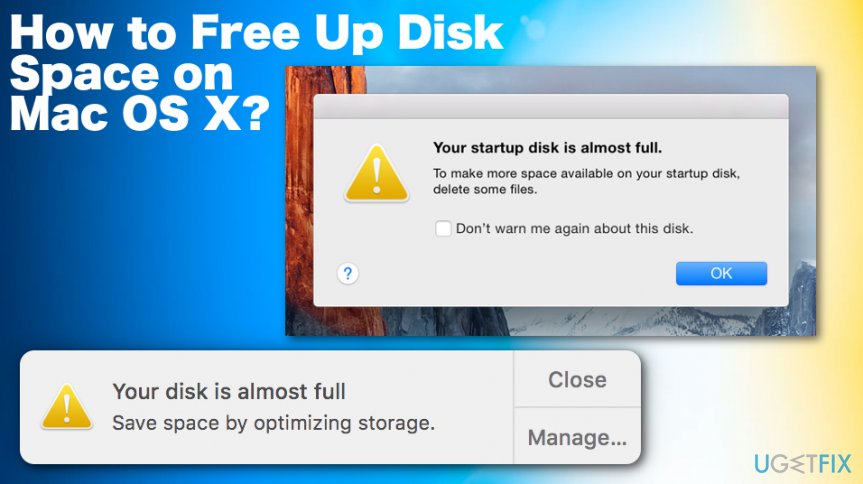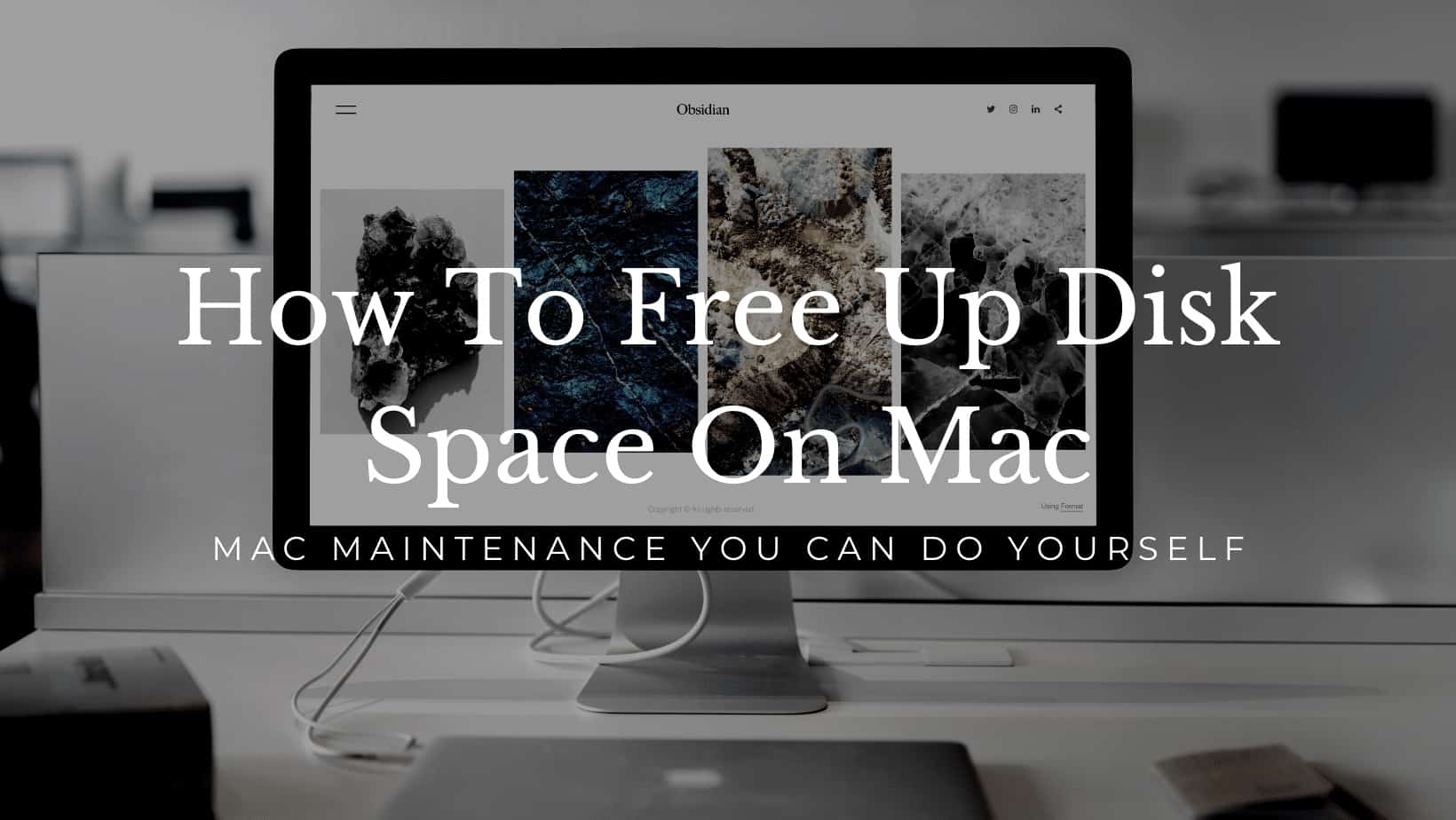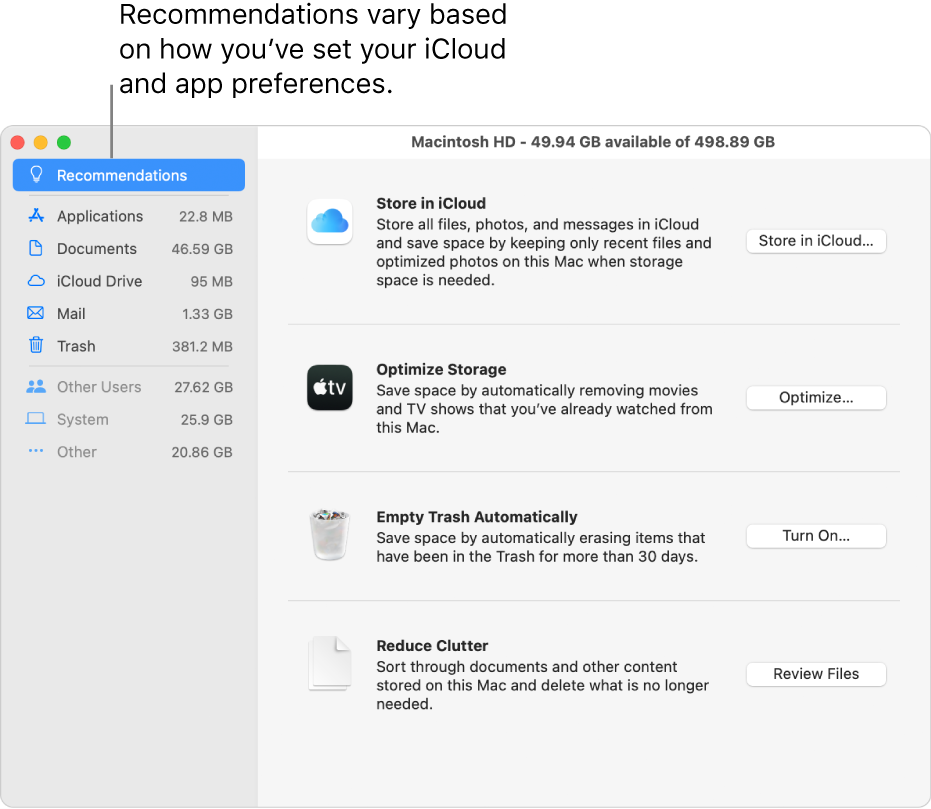How to Clean Your Mac's Hard Disk Drive?
SSD (Solid State Drives) is fast, stable, and offers great performance. Unfortunately, compared to HDDs (Hard Disk Drives), the capacity-to-cost ratio is not good. There are, however, methods to free up hard drives to obtain additional capacity for computer systems, including the macOS.
Nov 20, 2020 To free up disk space, it’s helpful to know exactly what is using disk space on your Mac. A hard disk analysis tool like Disk Inventory X will scan your Mac’s hard disk and display which folders and files are using up the most space. You can then delete these space hogs to free up space. Disk Space Analyzer; Disk Space Analyzer is not only a hard drive space visualizer but also a storage space cleaner. Besides the option to show the disk usage map, it can be used to quickly free up disk space on Mac. The application shows the size and other information for specific files and folders just by moving your mouse over the charts. How to free up space on a Mac? What is a “Mac Startup Disk”? Your Mac startup disk is a volume or a partition of a drive that contains a usable operating system. You can set your Mac to automatically use a specific startup volume, or you can temporarily override this choice at startup. To free up disk space on your Mac start with simple steps: empty Trash, delete files from the Downloads folder. If there is still not enough storage, then consider deleting large files. They can be found by clicking on About This Mac - Storage - Manage. Here are 8 of the best disk cleaning steps.
Certain data and files are important, and you will not want to delete or move them. However, some files are redundant and can be removed without consequences. If you know which files you can safely delete, you can free up this space. Although the Windows operating system is known for inefficient clutter, the macOS also produces unnecessary files that take valuable disk space. In this article, we describe some methods on how to clean macOS disk space.
Video showing How to Obtain Free Space on Your Mac's Drive
Table of Contents:
It is recommended to run a free scan with Combo Cleaner - a tool to detect malware and fix computer errors. You will need to purchase the full version to remove infections and eliminate computer errors. Free trial available. Combo Cleaner is owned and operated by Rcs Lt, the parent company of PCRisk.com read more.
Inspect the drive to ensure that the system is running out of free space
Some issues relating to lack of storage might be difficult to determine and can even be a result of fake error logs. So, first, ensure that the system is, in fact, running out of free space. There are two methods to check available space on a hard drive:
1. Access the Apple menu and select About this Mac. Choose the Storage tab.
2. More detailed information can be found within the Disk Utility feature, which is located in the Applications folder under Utilities. Once Disk Utility is launched, select the drive connected to the Mac.
Begin by cleaning Trash
Once you are sure that the drive is actually full, the next step is to simply clean the computer (as if you were cleaning your home: you empty the trash). Open the Finder menu and choose Empty Trash. Bear in mind that some applications, such as Mail, iMovie, iPhoto, and others, have their own Trash. To clean those apps, follow the steps below:
1. Click Mailbox and choose Erase Deleted Items.
2. Select In All Account and Mailbox.
3. Finally click Erase Junk.
Alternatively, to avoid permanently losing your files, choose to archive your emails by following the steps below.
iPhoto
1. Click on iPhoto from the menu at the top of the screen.
2. Choose Empty iPhoto Trash.
iMovie

1. Click on File from the menu on top of your screen.
2. Select Move to Trash or File.
3. Then choose Move Rejected Clipsto Trash.
Clear unnecessary Downloads
The Downloads folder stores all files downloaded from the Internet. Often, these are forgotten after use and continue to use storage space. This is an excellent area to address when looking to free up space on your drive. Delete all redundant Download files.
1. Open Finder.
2. In the sidebar, choose the Downloads folder. Disk image (.dmg) files commonly occupy the most unused storage space.
Remove unused applications
Unused apps in isolation might not take up a great deal of space, but the amount of hard drive storage used by them collectively can be significant. Furthermore, removing apps on Macs is simple, especially those installed through App Store.
1. To delete them, open Launchpad.
2. Click and hold the program's icon you wish to remove.
3. When the icon starts to animate, click the Delete (x) button.
4. To delete any other app, drag the icon to Trash and then empty Trash.
Make space without losing any data

The best way to gain extra space on the Mac is to move non-executable files such as photos, movies, documents, and any large files, to add external storage, for example, an external drive, USB drive, DVD/CD drive, or cloud storage.
Compress large items
Another method to obtain some free space is to compress files. Compressed files remain on the computer but occupy less space. On the other hand, this can be less efficient than deleting or moving files to external storage. To find the largest files on the drive, follow the steps below:
1. Open Finder from the sidebar.
2. Select the Device (the label you provided) and type criteria into the search field.
3. When your search location appears (for example, This Mac), click the Add (+) button.
4. Click the first drop-down menu, and choose Other.
5. Find the logical size option, enable it, and then click OK.
6. Choose the 'is greater than' condition and type the amount (i.e., 50 Mb).
7. To compress items, right-click or hold Control and left-click it, and then select the Compress 'name' option.
If you are using an earlier version of macOS:
1. Click Go from the Finder menu and select Home.
2. Choose File, click Find and open the Find menu.
3. Find the File size option.
4. Choose the 'is greater than' condition and type the amount (i.e., 50 Mb).
5. To compress items, right-click or hold Control and left-click it, and then select the Compress 'name' option.
6. To archive, your emails, open the Mail application and select a folder you wish to archive (e.g., Inbox).
7. Drag it to the desktop. The mbox folder will appear on your desktop.
8. Right-click it or use the Control and left-click combination, and select Compress 'Inbox.mbox'.
9. Now you can delete your messages from Mail.
Delete unnecessary temporary files, system caches, and logs
System stores several System logs and temporary files - deleting them will increase the available space on your drive. To clean the system from this type of file, we recommendCombo Cleaneror other third-party applications.
Clear the browser cache storage
Browsers store website data such as cookies and cache information. Cleaning these hidden files might free up storage space. To clean up Safari, simply click Safari on the menu at the top of the screen and select Clear History. Browsers such as Google Chrome and Mozilla Firefox can be cleaned similarly.
Contents
- How to free up space on a Mac?
- How to see the used Storage on a Mac?
- How to Fix Mac Startup Disk Full with pCloud Drive?
- Note: If you have very low disk storage you must do the following:
- Example:
If you are a Mac user and you have a smaller HDD Macbook, chances are you have seen this message at least once: “Your startup disk is almost full” or you want to know how to free up space.
In this article, I will explain why this happens and how to never see this warning ever again!
How to free up space on a Mac?
What is a “Mac Startup Disk”?
Your Mac startup disk is a volume or a partition of a drive that contains a usable operating system. You can set your Mac to automatically use a specific startup volume, or you can temporarily override this choice at startup.
What this means is that the startup disk is the “home” of all the files needed for starting your Mac and using it.
Without a startup disk, you will not be able to switch on your computer.
Why is my Mac “Startup Disk Full”?
In short, you have too many files. When this happens, it slows down all processes on your computer – see, in order to complete some tasks, your computer needs space to store temporary files and system files. When this happens and you run low on storage, the operating system needs to decide whether it can delete some files in order to complete the task. Most of the time this is not possible and the computer crashes or becomes very, very slow.
It is recommended that a startup disk should never be at above 85% of its capacity in order to work properly.
How to see the used Storage on a Mac?
If you want to see the exact types of files that are using the storage on your Mac:
Click the Apple in the top-left corner
Click on “Storage”
Currently, I have 73.9 GB used and 425.2 GB Free.
Most of my used storage is from “Other”
What is “Other” in the Mac Storage?
According to Apple, in OS X El Capitan or earlier versions, “Other” files are those that your Mac doesn’t recognize as belonging to any other category. These include files within disk images or archives, data stored by apps such as Contacts or Calendar, and app plug-ins or extensions. When your Mac is running in Safe Mode, all files are categorized as Other.
How to Fix Mac Startup Disk Full with pCloud Drive?
What is pCloud Drive
pCloud Drive is a desktop application that creates a secure virtual drive on your computer, which you can use to easily store, access and work with your files in the cloud.
To add files and folders to your pCloud Drive, simply drag and drop* your data into your virtual drive. You can then be sure that they are safely stored in the cloud and synchronized on all of your devices.
*for this to work fast you need to have at least some free storage on your startup disk. If you don’t, keep reading!
pCloud Drive provides a number of additional functionalities, such as integrated file sharing and synchronization through your computer.
Note: If you have very low disk storage you must do the following:

Choose the folder you want to Sync with pCloud:
Click on the pCloud icon and choose Sync to pCloud:
Create a folder on pCloud Drive:
Wait for the Sync to be completed:
This is very Important! After the Sync is finished, you must stop it with the cross icon:
After you stopped the Sync you can delete the files you just synchronized:

You can go to pCloud Drive and see the files you synced and use them as if they are on your computer! (A green icon means everything is synced.)
The app significantly eases your work upon performing file operations in the cloud, because with pCloud Drive you can work with your files using any software on your computer.
What this means is that if I have a vacation video in pCloud Drive I can watch it with no problem with the default video player on my computer. In my case VLC Player.
The best thing is that since the video is in pCloud Drive it is not actually on my computer but it’s in the cloud and does not take ANY of my Startup Disk Space!
Another awesome thing is that I can watch this video also on my phone with the pCloud mobile apps OR if I’m using a different computer that does not have pCloud Drive, I can watch it via Chrome, Firefox or any other internet browser. I just need to go to my.pcloud.com and sign in. Here is what I see:
Same thing works for:
– Documents – I can open and edit them with any text editor with pCloud Drive or access them from any of the other apps. The same works for worksheets, PDFs, presentations etc.
– Photos – I can open them, see them or edit them with Photoshop or any other image editor.
– Audio files – I can listen to them on my default music player or with pCloud mobile and web apps music player. I can even create playlists within pCloud.
– Every other type of file – As long as I have an app or a program to open the file with, there is no problem for pCloud Drive.
Nice right?!
What this means is that you can move all the files that are using your Mac Startup Disk Storage in pCloud Drive.
That way they WILL NOT use any of the space on your computer and you will still have access to them and use them with the apps installed.
Example:
I have a 512GB SSD Macbook Pro Retina. I also have a pCloud Premium account which is 500GB of storage. This makes my Macbook capable of storing 1TB worth of files.
Sharing with pCloud Drive
You can share any file or folder that you have in pCloud Drive.
You just right-click on the file or folder you want to share and choose if you want to invite someone to the folder or create a so called Download link.
This way you can collaborate with people or share the vacation photos and videos with your friends for example.
pCloud Speed
When you use pCloud Drive, you don’t even understand that your files are not stored locally. That’s because of the super high speed that we offer for uploading and downloading files. We compared our upload and download speed with the ones of Dropbox and here are the results for 1.12GB file:
pCloud Security
To guarantee your files’ safety, pCloud uses TLS/SSL encryption, applied when information is transferred from your device to the pCloud servers.
Your files are stored on at least three server locations in a highly secure data storage area.
Optionally, you can subscribe for pCloud Crypto and have your most important files encrypted and password protected. We provide the so-called client-side encryption, which, unlike server-side encryption, means that no one except you will have the keys for file decryption.
Conclusion
How To Free Disk Space On Mac
A lot of Mac users have the same frustrating problem. Startup Disk Storage fills up quickly on smaller versions (128GB and 256GB) and if you use it for work, you can fill up a 512GB Mac very fast too. Especially if you are a designer or a video editor for example, and work with large files. And even if you are not creating huge files, with the pace we are creating information is growing very fast:
Just think about this: smartphones and cameras that can shoot RAW files and in 4K, which means you’ll have photos and videos of amazing quality – but they will also take a lot of memory so the more space you have, the better.
pCloud Drive helps you virtually add storage to your Mac (or any PC for that matter). You can move your photos, videos, music, documents any other kinds of files there and use them as if they are on your device with the apps you are used to. Also, you can access them on a smartphone via the pCloud mobile apps for iOS, Android, and Windows 10 Mobile, and in a web browser when you go to the website and sign in.
Free Space On A Mac
P.S.
How To Free Disk Space On Macbook Air
If you never want to run out of storage on your iPhone too, read this.